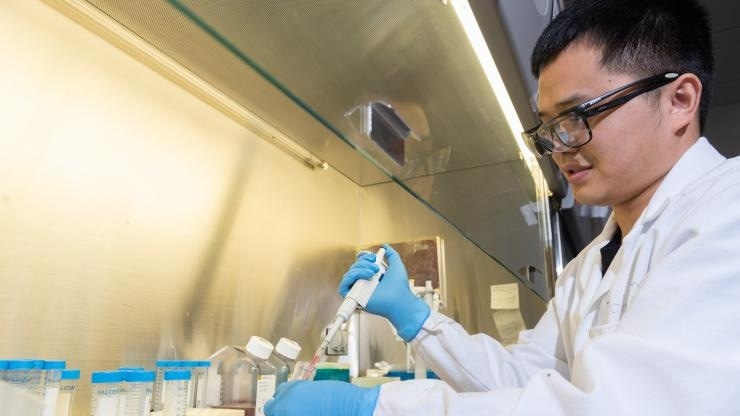Aug 19 2019
According to a new study, small silica bottles filled with a unique temperature-sensitive material and medicine may be used for drug delivery to destroy malignant cells only in specific parts of the body.
 Jichuan Qiu, a postdoctoral fellow at Georgia Tech, researches how nanoscale materials could be used in medical treatments. (Image credit: Allison Carter)
Jichuan Qiu, a postdoctoral fellow at Georgia Tech, researches how nanoscale materials could be used in medical treatments. (Image credit: Allison Carter)
This discovery was made by researchers from Georgia Institute of Technology (Georgia Tech) who recently published the study.
The researchers developed a method to produce silica-based hollow spheres that measured about 200 nm in size. Each sphere had a tiny hole in the surface that could allow it to encapsulate a broad range of payloads to be discharged at specific temperatures only.
The results of the study have been reported in the journal Angewandte Chemie International Edition on June 4th, 2019. In their study, the scientists described packing the silica-based hollow spheres with an anticancer drug, a near-infrared dye, and a mixture of fatty acids.
While the fatty acids stayed solid at human body temperature, it began to melt a few degrees above. When the dye absorbs an infrared laser, the fatty acids are rapidly melted to discharge the therapeutic drug.
This new method could allow infusion therapies to target specific parts of the body and potentially negating certain side effects because the medicine is released only where there’s an elevated temperature. The rest of the drug remains encapsulated by the solid fatty acids inside the bottles, which are biocompatible and biodegradable.
Younan Xia, Professor and Brock Family Chair in Wallace H. Coulter Department of Biomedical Engineering, Georgia Tech and Emory University
In addition, the scientists demonstrated that the size of the opening can be altered, allowing nanocapsules that discharge their payloads at varying rates.
“This approach holds great promise for medical applications that require drugs to be released in a controlled fashion and has advantages over other methods of controlled drug release,” Xia stated.
A technique was developed before to achieve controlled drug release. In this method, the temperature-sensitive material was loaded into low-density lipoproteins, which is usually called “bad cholesterol.” In another approach, the mixture was loaded into gold nanocages. According to the study, both methods have drawbacks in the way the material is used to encapsulate the drugs interacting with the body.
The researchers created the silica-based bottles by fabricating spheres from polystyrene that has a tiny gold nanoparticle integrated in its surface. Then, a silica-based material is used to coat the spheres except where the gold nanoparticle is integrated. When the polystyrene and gold are removed, just a hollow silica sphere with a tiny opening remains. The researchers can alter the size of the opening by just changing the size of the gold nanoparticle.
To load the bottles with their payload, the spheres have to be soaked in a solution containing the mixture, the trapped air needs to be removed, and the extra material and payload have to be washed away with water. The nanocapsules, thus obtained, contain a uniform mixture of the dye, the therapeutic drug, and the temperature-sensitive material.
In order to assess the release mechanism, the scientists placed the nanocapsules in water and heated up the dye using a near-infrared laser. They also simultaneously tracked the concentration of the released therapeutic drug. The test demonstrated that the medicine remained encapsulated without the use of the laser. Following several minutes of heating, the concentration of the therapeutic drug increased in the water.
This controlled release system enables us to deal with the adverse impacts associated with most chemotherapeutics by only releasing the drug at a dosage above the toxic level inside the diseased site.
Jichuan Qiu, Postdoctoral Fellow, Georgia Tech
Qiu is part of Xia’s group.
The study was supported by the National Science Foundation under grant No. ECCS-1542174 via the National Nanotechnology Coordinated Infrastructure. It was also supported by the China Scholarship Council via a graduate student fellowship.
Source: https://www.gatech.edu/